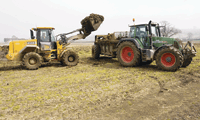Better manure analysis could halve fertiliser bills

Although fertiliser nitrogen and phosphate have fallen in price recently, NPK inputs still account for more than half of the variable costs of wheat. Last month triple superphosphate still cost £430/t, and muriate of potash £540/t.
It’s no wonder there have been suggestions of taking a P and K “holiday” in cereals. But with manures and biosolids more than able to make up the shortfall, such holidays could last a bit longer than some might expect, says Ken Smith of ADAS.
“For a fraction of the cost, organic residues not only satisfy immediate crop nutrient needs, but they contribute nutrients over the rotation, including some release of nitrogen over time. You can make substantial savings on N, P and K fertiliser inputs provided you know by how much to adjust fertiliser rates.”
Therein lies the challenge. Typical manure analysis data, for example tables in RB209, are useful for overall manure/fertiliser strategy. But for field level planning of N inputs, manure analysis is critical or you could be 300% out on N supply calculations, he warns.
Expensive
However, conventional laboratory manure analysis is expensive and slow, while hydrometers and N meters can give a reliable estimate of slurry N content, they can be fiddly to use, says Dr Smith. For solids, problems with sampling can give unreliable results.
“What growers need is an easily accessible, low cost, rapid service offering reliable analysis of manures.”
The first step was to develop robust and reliable calibration data for multi-nutrient analysis using a tried and tested technology. That technology was near infrared reflectance spectroscopy (NIRS), which has greatly improved precision and reliability in the analysis of forages, and is routinely used for the analysis of silage and grain. It works by measuring the infrared reflectance of a material, which is influenced by its composition.
Economics of waste: Potential estimated nutrient values of manures:
- Cattle slurry >£5/cu m
- Pig slurry £5.55/cu m
- Cattle FYM £11.50/t
- Pig FYM £12/t
- Broiler litter £46/t
- Layer manure £24/t
- Digested cake biosolids >£9/t
- Source: ADAS
More than 2000 samples of farm manures and biosolids are being used to calibrate Bruker’s Matrix-I NIRS machine. Dr Smith expects it to offer huge advantages, particularly in rapid processing of large samples and, being portable, the equipment could be set up in a location suitable for easy access, even running off batteries on farm.
The project is also looking to predict the availability and speed of N release from different manure types over time, as some have readily available N and others are mainly slow release forms. This procedure should enhance the capability of manure analysis over that previously available, and if successful, will contribute further to the development of decision support software such as MANNER and PLANET.
Dr Smith hopes a further potential application of this technology might be via an online scanner mounted, for example, on a muck spreader or tanker, analysing the composition of muck/slurry as it comes out of store to be spread.
The project is costing £858,000, with HGCA contributing £65,000. “Poorly managed manures are the most important potential source of environmental pollution,” Dr Smith says. “With the impending Water Framework Directive focusing attention on enhancing water quality at catchment scale, we really can’t do without a reliable and cost-effective means for extending the analysis of organic manures and residues on UK farms.”
SUMMARY:
- Project no. 3169: Reducing the risk of diffuse pollution by improving the nutrient assessment of manures and biosolids; ADAS, Agrivert, BPEX, Bruker Optics UK, DairyCo, EBLEX, Eurofins Laboratories, Grampian Country Pork Buckie, GrowHow UK, North Wyke Research, Potato Council, Severn Trent Water, Spreadwise, Yorkshire Water, DEFRA under a Sustainable Arable LINK programme; from October 2007 to December 2010.
HGCA PERSPECTIVE:
- Increasing appeal of organic manures due to high cost of inorganic fertilisers
- Further nutrient content analysis offers greater scope for reducing fertiliser inputs, maximising farm profits
- Better management will ease compliance with NVZs
- Interim report available from HGCA
CROPS PERSPECTIVE
- Say goodbye to guesswork. With a new accurate method for assessing N, P, sulphur and organic carbon, growers will be able to substitute fertilisers with manures and biosolids knowing they are satisfying crop and soil needs. This project should not only save money but will help protect the environment.

